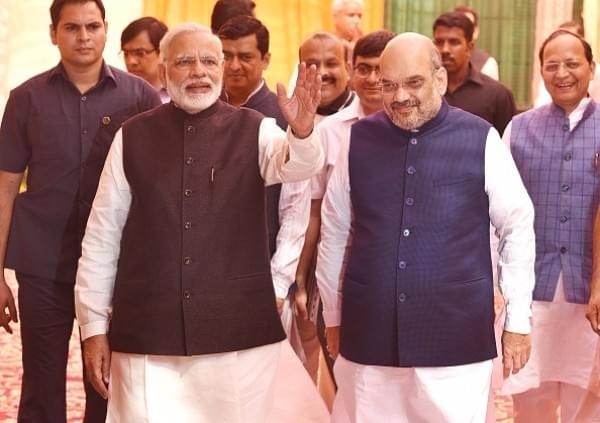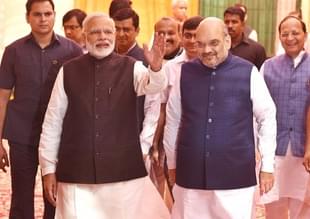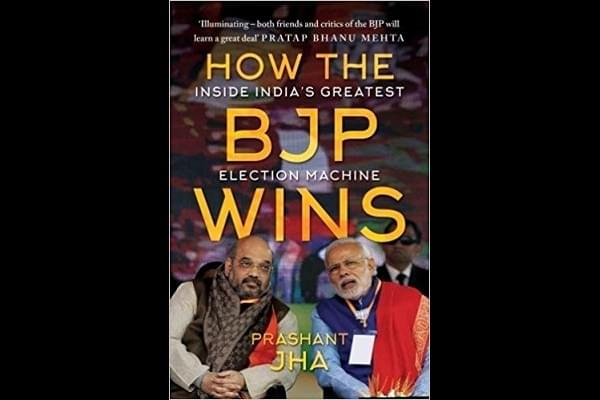Books
BJP’s Transformation Into A Resurgent Force Under Modi-Shah Leadership
Vikas Saraswat
Nov 25, 2017, 10:55 AM | Updated 10:55 AM IST
Save & read from anywhere!
Bookmark stories for easy access on any device or the Swarajya app.


In 1988, as a 15-year-old, I had accompanied my father to Deen Dayal Dham – the venue at Agra for the eight-year-old Bharatiya Janata Party’s (BJP) national executive meet. Seated at the dais were Rajmata Scindia, Lal Krishna Advani, Atal Behari Vajpayee, and Sikandar Bakht. No one else, not even Murali Manohar Joshi, was a recognisable face to me.
As a curious child brought up in a pro-Jan Sangh environment, I asked my father if the party had any chance of winning the upcoming Lok Sabha elections. “Not in the next 50 years,” he replied with a smile. I vividly remember the interaction because his words were a crushing disappointment. His reasoning was simple. “BJP is a party of urban educated.” He might as well have added, “of the cow belt”. I too realised that a number of our relatives and family friends in cities were supporters of the BJP (Jan Sanghi as they would like to identify themselves), but those in villages had neither any love nor patience for the party. They found it “paise walon ki party, party of the rich”.
A major shift was going to come about next year, and less than three decades later, on 16 May 2014, the ‘certitude’ in my father’s pronouncement was being belied for the third time. Unlike 1998 and 1999, it was particularly impressive this time because not even the most ardent of BJP supporters had expected the party to secure a clear majority on its own. A series of electoral victories in assembly elections since 2014 has enlarged the party’s footprints across India. In less than four decades of its existence, the BJP has transformed from a party whose cadre would strive and persevere even if it meant “a hundred years of struggle for power”, to a political force which is very much here and now. The party had morphed from a grouping of diffident, docile gentlemen who would be unable to manage one vote in Parliament even after being the incumbent, to a ruthlessly ambitious pursuer of power aiming to wrest control of states where none expected them to do so.
For such a major political phenomenon to have been dealt with in the form of a book, Prashant Jha’s How the BJP Wins comes at the most appropriate time. Charting the political developments of the last four years in the party, parsing the social changes in the Indian electorate and party organisation, and analysing the electoral strategies of an aggressive leadership, the book offers fascinating insights into the workings of the BJP. A large number of interactions with an array of people, a sharp journalistic acumen, astute observations, and honest anecdotal narrations lend significance to Jha’s efforts.
Although the book primarily focuses on the party’s organisational workings, dynamic strategy making and smart electoral campaigning, it is essentially a story of BJP’s transformation into a confident and resurgent force under Prime Minister Narendra Modi and party president Amit Shah in the last couple of years.
The portentous development is best summed up by Jha himself in the book’s introduction. “The BJP's rise, through that quintessentially democratic practice of elections, is one of the most fascinating stories of contemporary India. It has altered politics, created new social conditions, dissolved older fault lines, generated new conflicts, empowered some, alienated others and is having a profound impact on state institutions.” The profundity is, of course, tampered by Jha’s opinions. And though his confusion of cultural nationalism with ‘religion’ is debatable, the broad gist isn’t. Jha continues, “When a charismatic national leader, a powerful strategist, astute social alliances, a formidable ideological and organisational infrastructure, religion and a ruthlessly ambitious, pragmatic and flexible culture merge, politics and democracy, can change, perhaps irrevocably and in unanticipated ways.”
Unlike a lot of commentators who persist with the labeling of the BJP as an upper-caste North Indian Hindu hegemony, Jha recognises that is no more the case. Detailing at length the party’s efforts to assimilate “backward castes” and “Dalits”, Jha summarises, “Just as the BJP is no longer an upper-caste Party, it is no longer a North Indian party.” Elaborating the ambitious social engineering exercise which the BJP undertook to expand its base, the book narrates radical changes effected by Amit Shah. Taking, for instance, the case of Uttar Pradesh, where he was made in charge in the run up to the 2014 Lok Sabha elections, Jha tells us how the party discovered “that among party office bearers across the states - from Lucknow down to the district level - only 7 percent were OBCs and 3 percent were Dalits (but) within two years their share had spiked to 30 percent.” Further, “of the 75 district presidents, 34 were now OBCs, and 3 were Scheduled Castes”, besides state party president Keshav Prasad Maurya, hailing from a “backward caste”. As expected, the party reaped the benefits of the exercise. “For the first time ever, nationally, the BJP got more Dalit and Scheduled Tribe votes than the Congress.”
If social engineering explained the party’s success in Uttar Pradesh, Maharashtra and Haryana assembly and Lok Sabha elections, it also pointed out the main reason for its loss in Bihar where “Lalu ... converted the polls into an upper caste versus OBC election”. A major contrast between the elections in Uttar Pradesh and Bihar was also the ticket distribution. While in Bihar, the BJP “gave too many tickets to upper castes in the first list ... (making it easy) for Lalu to portray (it) as a party of forwards”, Uttar Pradesh was a different story where it had “given the highest number of tickets to OBCs in its electoral history”. The party also suffered because of its perceived “pro rich and anti farmer” image due to the Land Acquisition Act and Rahul Gandhi’s “suit boot ki sarkaar” jibe. However, the party was quick to draw its lessons from the loss in Bihar. Jha writes, “In the speech where Rahul Gandhi had used the suit boot ki sarkaar jibe, he had also offered advice to Modi. ‘Sixty percent people are farmers and labourers. The PM will gain politically if he changes sides’. What demonetisation did, and the content of Modi’s Moradabad speech makes it clear, was help crystallise this change in sides. It ended once and for all the perception that it was 'suit boot ki sarkaar’.”

Although much scoffed at by its opponents for the claim, the book also reveals, rather inadvertently, how the BJP is indeed a party with a difference. The rise of not only Modi and Shah but several others like Devendra Fadnavis, Manoharlal Khattar, Bhupendra Yadav, Sunil Bansal, Keshav Prasad Maurya, Amit Malviya and Chandramohan to positions of power and responsibility at different levels, not because of their pedigree or connections but loyalty to the party and organisational capabilities, proves its democratic credentials. The nurturing of young ignited minds like Shubhrastha and Rachit Sethi, which Jha recounts in some detail, by affiliate bodies like the India Foundation tells us about an ecosystem where merit and not sycophancy is rewarded. But above all, the claim is justified by party sympathisers from different professions and vocations selflessly pitching in their time and resources. That an influential chunk of this lot is either aligned or sympathetic to the Rashtriya Swayamsevak Sangh and its affiliates helps the party in more ways than one. It acts as a moral check on elected legislatures and provides the infrastructure of a socio-cultural body with a massive reach to bank upon.
If Shah’s sangathan, to which Jha devotes an entire chapter, and enthusiasm of the sympathisers have played a crucial role, the prime element in the BJP’s phenomenal rise has undoubtedly been the leadership of Prime Minister Narendra Modi. In independent India, only two other leaders, Jawaharlal Nehru and Indira Gandhi, have commanded similar awe and respect. But unlike the father-daughter duo, neither is Modi a political dynast nor a beneficiary of an emotional legacy (independence in Nehru’s case and her father’s memory in Indira’s). His political capital has been based on his proven track record of governance in Gujarat and sheer grit in the face of establishment hostility. Hailing from a lower-middle class family, Prime Minister Modi has had to contend with a far bitter and fractured politics than the Congress hegemony of the first four decades. The way he was catapulted to the national scene as a prime challenger to the prime minister’s post against stiff resistance from the central leadership of the party itself, he came to truly represent the voice of the nation. An aspirational India, particularly its youth, see in him a hope for a better future. For a nation which has suffered a bloody partition just seven decades ago and continues to be riled by jihadi and Naxal secessionism, he is looked upon as a bulwark against their nefarious designs. In a vexatious pseudo-liberal discourse which prides itself on its anti-Hinduism and promotes all hues of anti nationalism, Modi as a cultural nationalist, unapologetic of his Hindu identity, thumbs his nose at the opponents.
For the liberal commentariat, including Jha, this pride, even if it comes with the Prime Minister’s assurance that he wouldn’t allow anybody’s honour to be messed with – “kisi ki pagdi nahin uchhalne doonga” – is still a matter of concern. It has failed to assuage their worries after elections, even when the Prime Minister has been accused of issuing warnings only to “Gau Rakshak” vigilantes and not cow slaughterers, killings by whom far outnumber the former. His politics, for the liberal crowd, remains “divisive” even if he warns only “Gau Rakshaks” and speaks not a word on the killings of his partymen in state after state. The epithet “Hindu Hriday Samrat” for Modi by some, in such an understanding, becomes bothersome for the author even if he has decisively earned two more sobriquets “Vikas Purush” and “Gareebon ka neta”, attested to by Jha himself.
And despite the “extraordinary faith in the intentions and integrity” of Modi, which Jha encounters in “towns, streets and villages of UP”, despite the success of “three central government initiatives... gas cylinders (Ujjwala scheme); toilets (Swachh Bharat); and Jan Dhan accounts”, and despite him having “reinvigorated a lethargic bureaucracy, used the network provided by Aadhar and deployed his own capital to add urgency to implementation”, Modi is somehow a clever manipulator who plays with emotions and works up the crowds with his cunningness. Jha’s laboured psychoanalysis of Modi’s speeches in the book are threeway revelations – how Modi reaches out to the masses, how the masses perceive his message and how the intelligentsia reads them – last of these being the litany of woes repeated ceremonially with equal fervour every time. There is praise for his deftness, energy and courage, his willingness “to jump into the fray with zeal (without being) scared of defeat”, and his communication skills. But the grudging admiration is qualified by instinctive distrust and usual cynicism.
At the root of this rancour is the ‘S’ bias. The cryptic verbage is a literal response to Jha’s idiom, “H-M Chunav”, for the title of one chapter in his book which charges the BJP of communalising politics. But is it really the BJP which polarises the electorate, or is it a case of the party benefiting from an already polarised electorate? Can a political party “whip up passions” without existing fault lines? Is there no challenge to the ethos of the land from expansionist ideologies which do not hesitate in resorting to violence? Can one deny concerted attempts to foist Islamist agenda on national politics? Doesn't mockery of symbols and undermining the ideals of nationhood deserve a political response? Shouldn’t mobilisation to resist these strands be considered a legitimate political pursuit? Can the same be done without a political party articulating these concerns in legislative assemblies or election campaigns?
In the liberal reckoning, any mention of the communal problem even in the most civil terms is a holy horror. Despite the fact that radical Islam attempts to expand its influence in the physical, conversational and legal realms, despite its recurring intransigence on social issues which resulted in the partition, and despite the Muslim appeasement in both policies and day-to-day governance, the discussion of the “I problem” remains a taboo. No wonder, Jha finds BJP leadership responsible for Muzaffarnagar riots, Hindu migration from Kairana, election time rhetoric, love jihad, and fear-mongering to scare Hindus. He views Modi’s remarks at Fatehpur, “if a graveyard is made in a village, a crematorium must also be built” as “meant to make Hindus bitter”.
Ideologies as fashion can be as crippling to intellect as dogma to the devout. Secularism is a classic example. Like alcohol, it is inebriating. Like alcohol, it lulls the senses, impairs the brain and alters consciousness. Perceptory reality gives way to visions, ones in which unlike the rest of the world, one sees illusions borne out of obsessions and prejudices. This “S bias” perfectly explains why an otherwise sagacious Jha fails to see Muslim belligerence, which so many others in the society can. The extent of mistrust for secularism among Hindus is revealed by Jha himself. He writes, “I met hundreds and hundreds of people - from every community. But through this journey I did not hear a single Hindu utter the word which has defined national politics for so long - secularism. Muslims, yes, continue to use the word. They look longingly at ‘secular parties’. Politicians from these parties too, sporadically, use the term to appeal for votes from minorities. But even those Hindus who were not voting for the BJP, who belonged to the SP families, who were traditional BSP supporters, who were with the Congress, had a set of reasons to support their respective parties. The reason they never offered was secularism.”
Even if left liberals would like to read it differently, the sentiment does not imply that Hindus are done with secularism as a social value. It only reflects the loss of credibility of secularism as a slogan. An overwhelming number of Hindus, even if they are not voting for the BJP, recognises the perversion of discourse in the name of secularism. This perception, coupled with a hope for a better future as a nation and enabled by a charismatic leadership is “why” the BJP is winning. The “how” can be explained by “Shah’s sangathan”.
Political analyses which view electoral politics only as a response to strategy, caste combinations, money or election rhetoric fail to do complete justice. One election here or there may not mean much, but a steady shift in political sands indicates changes in the socio-cultural values of a society. Such a fundamental shift should be recognised more as an assertion of popular will rather than political craft and guile influencing the public. The BJP’s successive electoral victories denote an aspirational India which also seeks to rediscover its civilisational glory. Jha’s fear of “development card, the law and order card, and the Hindu card juxtaposed cleverly into a common narrative” is paranoia of the cynic. In fact, one should be glad that the change is being effected democratically.
However, despite its secular blinkers, the book is valuable for the depth of its coverage of the subject and percipience. It provides interesting insights into the functioning of political parties and their distinct working styles. Both critics and supporters of the BJP will find it useful to enhance their understanding.





